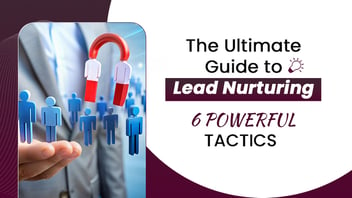
Education Lead Generation: How to Convert Prospects into Buying Customers
In this article, we're going to dive deep into the art of lead generation and explore some unique ways to generate education leads for your institutional products and services.
Education leads are the contact information of individuals/ organizations who have expressed an interest in a similar kind of product/service you provide in the education sector. They can be generated through various channels like social media, website visits, events, or even word of mouth.
According to studies, a business that nurtures its leads by providing valuable information and building relationships with them generates 50% more sales-ready leads at a 33% lower cost. So, it's important to not only generate leads but also to nurture and convert them.
So, let's unleash how to generate leads for education B2B marketers, like yourself and turn them into lifelong learners with our out-of-the-box strategies.
Try Education Outbound Marketing
Outbound marketing is the OG of all marketing methods. First, you figure out who you want to talk to, and then you give your message as loud as possible.
Examples of outbound marketing include radio commercials, cold calls, TV ads, flyers, catalogs, brochures, trade shows, and even email blasts. Sure, it's not as fancy as inbound marketing, but it's still a favorite among organizations and they often spend a lot of their budget on it.
You can catch your target education industry decision-makers using outbound marketing. It may involve creating a catchy commercial promoting their service/product, handing out flyers at local events, or even hosting a booth at a college fair.
Types Of Outbound Lead Gen Tactics To Attract Key Decision Makers
Are you familiar with the terms "above-the-line" (ATL) and "below-the-line" (BTL)? These are buzzwords you might have heard when it comes to traditional media or advertising.
To put it simply, ATL refers to more traditional forms of advertising, like radio, TV, and billboards. On the other hand, BTL is all about more targeted and direct forms of marketing, like events, email campaigns, and promotions.
But, how can you get your brand out there and boost sales? Well, there are plenty of outbound marketing channels you can try out.
Here are the top five channels to employ your strategies for higher education lead generation to keep the ball rolling:
1. Through-the-line (TTL) Advertising
With TTL, you get to take advantage of both below-the-line (BTL) and above-the-line (ATL) ad types. It means you can run an awareness campaign across a variety of different channels, like newspapers, TV, and social media platforms, all at once. Pretty cool, right?
One of the newer and emerging forms of TTL is digital-out-of-home (DOOH) advertising, in which you can use traditional outdoor media (like billboards) to display dynamic ads that change in real-time.
2. Content Syndication
The idea of content syndication is to publish all your content on a third-party website and distribute it through various channels. This could be an interview, a guest post, or a rehash of an existing article from your own website. It's a way to get your message out there and reach a whole new audience.
Sometimes, content syndication can happen through brand collaborations, too. It means you work with another brand to create a really compelling piece of content, like a downloadable guide. It's a win-win situation, as brands get to share the content and reach a wider audience.
And while you're at it, you might want to check out "content discovery platforms" as well. These are similar to content syndication, but they're a part of native advertising. Advertisers can place their content on third-party publishing websites with this platform.
The downside is that content discovery platforms require publishers to drive a minimum fixed monthly traffic of approximately 10 million page views per month to be eligible to place native ad slots. But it's a great way to amplify the reach of your content.
3. Cold Emails
If you're running an education-based SaaS startup, sending cold emails can be a valid customer acquisition strategy in the early days. Just ask Justin McGill, the founder of LeadFuze, who incorporated cold emails to get $30k monthly recurring revenue.
Here's how he did it:
- Find and reach out to your target customer
- Craft a personalized outreach plan (not the typical marketing message)
- Follow-up
He also used his own product to search for the email addresses of potential clients, which made it easier. But it can also be done without it, all it takes is research.
4. Cold calls
Do you know what a great way to reach out to new potential customers is?
Cold calling!
It's when a sales representative directly calls up a customer to try and make a sale.
It's similar to emailing, but you're giving them a call instead of sending an email. The idea is to increase profit by offering customers deals, package offers, and limited-time opportunities.
But it's not just about reaching out to new customers. Cold calling can also reconnect with previous customers and turn them into repeat customers. You can ask about their experience or even suggest new products to them based on their preferences.
5. Tradeshows and Events
If you want to meet potential customers face-to-face and build some high-quality leads, you should check out trade shows and events!
You might not generate as many leads as you would with something like cold email outreach. But the leads and connections you make are often of a much higher quality.
If your brand is represented at a prestigious event or trade show, it shows that you're not a fly-by-night operation. It's an opportunity for organizations to meet prospects and customers in person and create contacts, convert potential customers, and retain existing ones.
Corporations can host their own events, like Salesforce's Dreamforce, or sponsor or attend events or conferences hosted by third parties. It will help in networking and making some valuable connections.
Differences Between Education Inbound Marketing And Outbound Marketing

Outbound marketing is all about reaching out to customers to get them interested in your product, while inbound marketing is more about creating and sharing content that draws customers to your website.
Outbound marketing is a more wide-sweeping approach, while inbound focuses on convincing a smaller group of individuals about the superiority of your products or services.
While outbound marketing is a more direct approach to a potential customer, it is equally or more (in some cases, i.e, when marketing to a highly regulated industry) as effective in appealing to the customer as inbound marketing. Outbound marketing contacts a customer directly, which is a good way to open a discussion on your product’s benefits.
Inbound marketing, on the other hand, is all about encountering a customer while engaging with their hobbies or interests through a blog and social media posts or while browsing the web. It pertains to their interests and arrives at a time when they are already engaging with content. However, lead generation through inbound marketing is comparatively time-consuming.
Should You Move From Inbound To Outbound Marketing For Higher Education?
Outbound marketing has been one of the consistent marketing approaches, but let's tell you, it's alive and well. Also, it will become a more popular marketing strategy in the coming years.
Inbound marketing is all the rage, but outbound marketing is not going away any time soon. In fact, it's projected to grow at a steady rate through 2023 and beyond.
As we move into the 21st century, outbound marketing is becoming more important, with consumers being flooded with advertisements from all angles. Outbound marketing is a way to break through the noise and reach your target consumers directly.
Now, both outbound and inbound marketing have their own pros and cons.
For example, all the inbound marketing success stories share one thing: they own their content creation efforts in-house. So, instead of hiring advertising specialists, you'll need to invest in hiring a content manager to really do inbound well.
Your best bet, however, is to focus like a laser on a single goal – to differentiate yourself as the No. 1 expert about what it is that you do or sell. Only then can you leverage both inbound and outbound tactics to drive the traffic, leads and sales that you're looking for.
But we can say that you should follow both inbound and outbound marketing strategies simultaneously to get more education leads.
Tools That Leverage Lead Generation For The Education Sector

Now that you know the best lead generation tactics for higher education targets, it's time to explore the tools you can use. The most common lead generation tools that are available are as follows:
1. LinkedIn Ads
By incorporating LinkedIn into your higher education lead generation strategy, you can promote your research and webinars on the subject that your target prospects would like to explore. Adopt a dual approach using LinkedIn InMail and Sponsored Updates.
Sponsored Updates are used to promote upcoming webinars and content from the business school’s thought leadership platform, QSB Insight. And InMail is used to increase the number of individuals who signed up for information sessions on degree programs.
The ads were targeted based on seniority, education level, geography, and company size, which help institutions to reach the right audience.
There are other ways to promote your institution on LinkedIn, and a few other great practices include:
- Utilize LinkedIn's analytics tools to regularly review metrics like views and interactions. With this, you can identify the types of posts that have the most impact on your audience.
- Ensure that key administrators such as the president, have an active and engaging presence on their profiles.
- Take a look at LinkedIn's resources for higher education marketing to learn how to create effective content and access helpful guides.
2. Chatbots
Are you looking for a way to make it easy for prospective students to get the information they need about the higher education institution? Look no further than chatbots! These digital tools can help you attract and convert the most qualified leads by providing 24/7 access to key information.
Prospective students often have a lot of questions about things like fees, course content, and accommodation. While you can provide this information on your website, some people may prefer to ask their questions directly. But responding to every question individually can be time-consuming and overwhelming.
Chatbots can help by automatically answering questions, so your admissions team can focus on other important tasks. Plus, chatbots can handle multiple conversations at once to help you reach more leads at the same time.
3. Create email workflows
Want to make sure that your emails are getting to the right people and making an impact? Personalization is the key, and it all starts with segmentation.
To get the most out of your email lists, try to divide them as specifically as possible. For example, categorize leads based on their interests, and also sort them by what stage they're at in your sales funnel.
A robust Customer Relationship Management (CRM) platform can assist you in capturing relevant information, setting triggers, and automating personalized emails. It caters to their unique needs, requirements, and workflows.
Conclusion
Outbound marketing is a blast for marketers looking to generate education leads in the education sector. Introduce your academic solution on your company's page, connect with communities and groups where your target group might be present, and, most significantly, mold your marketing approach preferred by your targeted prospects and decision-makers.
Revnew can help you start your journey to elevate your company as a leader in the educational sector. It connects your marketing team with qualified and high-value prospects by reaching out to them on your behalf. Do check out its offers and services.




